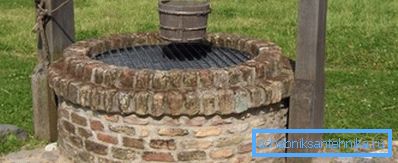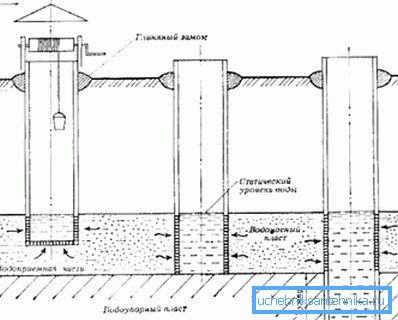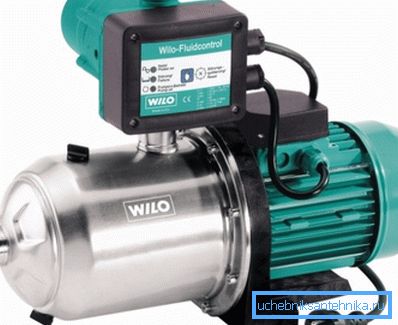Wells for water: types and features of their operation
What types of water wells are in demand today? Which ones are better and which ones have certain characteristic disadvantages? These and similar questions interest many compatriots whose country houses and cottages are built far from the centralized water supply lines.

Well classification
In accordance with the design features, all wells can be divided into the following categories:
- key;
- mine;
- pipe;
- tubular.
Key well
The key well for water is considered the simplest and economical both in construction, and in the subsequent operation. Such structures are of two types: descending and ascending.

The construction instructions for the ascending well are as follows:
- The place where the ascending key comes to the surface is leveled and deepened. The resulting deepening strengthened with stones or bricks.
- In the recess install the log cabin. The log house can be made of wood in the form of a barrel or a box without a bottom. If possible, the frame is made of concrete. We set the well frame in such a way that the lower edge is located below the water level.
- If the height of the log house is greater than the upper level of the water rise, then it is necessary to make a drain hole in it.
- Since the drain water must be removed from the well as far as possible, we dig a ditch under the drain. We dab the walls of the ditch with a layer of clay and wait until the clay is completely dry. For reliability, the ditch from the inside can be laid out with stone-flagstone.
- Next, we make a thick solution of clay and gloss over the gaps between the walls of the frame and the walls of the recess.
- Around the log of the upper layer of clay we fall asleep rubble or gravel.
- At the bottom of the well we arrange a bottom filter for a well made of gravel, crushed stone or large river sand. The thickness of the filter should be from 15 to 30 cm.
- Around the whole well we make a pavement of clay coated with stone-flagstone, brick or concrete.
Important: After you have taken water from the well, be sure to close it with a tight lid so that precipitations and garbage do not fall inside.

The structural features of the descending key well largely explain the low quality of the water and the high content of sludge particles, soil, etc. in it.
As in the case of the ascending well, we install a blockhouse in the recess, which can be made of any materials. The bottom of the log house must be lined with stone, brick, concrete or wood.
The blockhouse of such a well must be equipped with a transverse partition so that the water below can stand and get up cleaned. Instead of the traditional log house, you can use a concrete pipe of the appropriate diameter. The partition is also installed in the pipe, designed for water purification. On the side from which water flows, rubble or gravel is poured.
Mine wells

Despite the fact that key wells are economical and easy to use, their location is determined by the presence of ascending or descending keys, the search for which is difficult. Therefore, in some areas it is preferable to use shaft wells.
Such structures are a mine with a depth of 10 to 30 meters. The diameter of the mine section can reach one and a half meters.
Mine-type wells can be made in various configurations.
For example, according to the type of building materials, mine wells may be:
- concrete;
- stone;
- brick;
- wooden.

In addition, the shape of the mine structures can be round, square, rectangular.
In accordance with the method of water intake, mine wells are divided into the following modifications:
- key (water is collected from the bottom);
- prefabricated (water seeps through the side walls and to a lesser extent through the bottom).
The part of the mine located above the ground is called the tip. The cap, provided the device is properly installed, protects the shaft from clogging with debris and foreign objects. In addition, during the cold season, the tip prevents the inside of the well from freezing and icing. For this purpose, a more or less canvas closure lid is provided in the head construction.
The underground part of the water intake is called the trunk. The trunks differ in the shape of a peppered section. For example, they can be round, square, rectangular and hexagonal.
The middle part of the trunk - a log house can be made of dry dense wood. In this case, the crowns are stacked as tightly as possible, so as to prevent water and small particles of soil from passing between them. In modern constructions, wood is everywhere replaced by reinforced concrete rings for well constructions or by brick and masonry.
The lower part - the sump performs the function of a water intake, that is, is used to store water. This part of the barrel is made using the most durable materials.
Important: Bar sizes are determined by the volume of daily water consumption. If the dimensions of the water intake shaft are too large and the contents of the barrel are not consumed for a long time, stagnation occurs, as a result of which the initial consumer properties of water are lost.
Tube wells
This type of well is a well drilled to groundwater. The construction is called a pipe because of the round shape. Wells for the arrangement of such wells are drilled with special equipment, as the water lies at a depth of about 30 meters. However, if there are no access roads to the site, it is necessary to drill by the shock-rope method manually.

As a rule, manual drilling begins with digging a square shaft or a hole with an average depth of up to 2 m and a width of up to 1.5 m. In order to prevent the collapse of the walls of the hole, we additionally sheathe them with slab or unwanted planks. Due to the removal of the fragile soil layer prior to the start of work, the collapse of the barrel when removing the drill from the well can be avoided.
In more detail about drilling and arrangement of wells manually it is told in the relevant articles on our portal.
Tubular well

If you wish, you can build a tubular well with your own hands. There are several modifications of this structure and they are all easy to implement and easy to maintain.
Among the wells of the tubular type, the following modifications are widespread:
- Abyssinian (driven) wells;
- deep wells;
- asbestos-cement pipes.
The Abyssinian well is of the greatest interest. This method of building a water intake shaft is optimal for use in areas with unknown parameters of the aquifer. Using this method, during the day, you can check for the presence of water the entire dacha or garden plot.
The fact is that the diameter of the trunk is only 1.5-2.5 cm, and therefore the detection of water for the well is not difficult. The barrel is literally squeezed out in the ground by a narrow hollow pipe with a sharp cut edge.
The pipe is clogged to the full depth, then removed and released from the soil that has gotten inside. Then the pipe is re-inserted into the hole, built up with a removable rod and re-dredged, and so on until water is detected.
Conclusion
The price of a professionally designed and constructed well is high. It is much more profitable to cope with this work independently, without attracting professional specialists.
As you can see, the range of water intake facilities is wide, and therefore everyone can choose the most suitable option. More interesting and useful information can be found by watching the video in this article.